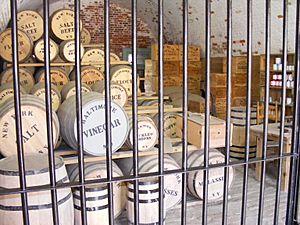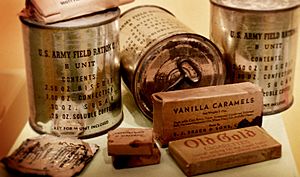United States military ration facts for kids
United States military rations are special food packages given to members of the U.S. armed forces. These rations are made to be easy to hand out, prepare, and eat, especially when soldiers are out in the field. They are often packaged very well and can last a long time, even in tough conditions. Today, the main ration used is called the Meal, Ready-to-Eat (MRE).
How Military Food Has Changed Over Time
Early Days: 1700s and 1800s
From the Revolutionary War up to the Spanish–American War, U.S. soldiers usually received a "garrison ration." This food package included meat or salt fish, bread (often hard biscuits called hardtack), and vegetables.
For a while, soldiers also received a drink ration. In 1785, it was four ounces of rum. Later, in 1790, it changed to two ounces of whiskey, brandy, or rum. This drink ration was stopped in 1832 and replaced with coffee and sugar.
During the American Civil War, both sides found it hard to feed their soldiers enough. Getting food to the troops was a big challenge, leading to many different kinds of rations being used.
World War I: New Rations for New Challenges
In World War I, American soldiers started using three main types of rations: the Reserve ration, the Trench ration, and the Emergency ration (also known as the Iron ration).
The "Iron Ration" (1907–1922)
The "iron ration" was the first attempt to create a single meal for soldiers in the field. It came out in 1907. This ration included three small cakes made from beef broth powder and cooked wheat. It also had three bars of sweet chocolate, plus small packets of salt and pepper. All of this came in a sealed tin box. It was meant for emergencies when soldiers couldn't get regular food.
The "Trench Ration" (1914–1918)
This ration was used early in World War I. Soldiers on the front lines needed food, but meals cooked in field kitchens sometimes got ruined by gas attacks. The trench ration was the solution. It was a mix of canned meats like salmon, corned beef, and sardines. These were bought from stores and packed in a large, heavy tin box covered in canvas. Soldiers soon got tired of the limited choices, and it was replaced by the Reserve Ration.
The "Reserve Ration" (1917–1937)
The reserve ration was first given out during the later part of World War I. It was for troops who were away from their main camps or kitchens. It usually had 12 ounces of fresh bacon or one pound of canned meat, often corned beef. It also included two cans of hard bread or hardtack biscuits, a packet of coffee, sugar, and salt. Sometimes, a small amount of tobacco and cigarette rolling papers were also given out.
After the war, people tried to make the ration better. In 1922, the meat part was changed to include dried beef and canned corned beef. Later, in 1925, the dried beef was removed, and canned pork and beans were added instead. By 1938, this ration was replaced by the Field Ration, Type C.
World War II Field Rations
After 1918, the army's food system changed a lot, leading to several new types of rations during World War II:
- A-ration: This was the "Garrison Ration." It was fresh, refrigerated, or frozen food cooked in dining halls or big field kitchens. It was the most preferred type of food.
- B-ration: This was the "Field Ration." It included canned, packaged, or preserved foods. These were usually cooked in field kitchens without needing a refrigerator.
- C-ration: This was an "Individual Ration." It was a complete, pre-cooked meal in a can, ready to eat.
- K-ration: This was another "Individual Ration." It was designed as a short-term meal for paratroopers and other special forces. It was stopped after 1948.
- D-ration: This was an "Emergency Ration." It was a bar of very concentrated chocolate mixed with other ingredients to give a lot of energy. It was meant for emergencies.
A-rations and B-rations were only served at bases or established camps behind the front lines because they needed cooking. C-rations could be eaten hot or cold and didn't need special cooking or storage. This meant they could be given out almost anywhere.
During the war, a new ration called the 2,830 calories (11,800 kJ) K-ration was made for assault troops. K-rations were supposed to be used for only 2–3 days. However, because of costs and standardization, they were used too much. This sometimes led to soldiers not getting enough vitamins and nutrients.
Many other special rations were created for specific situations, such as:
- Type X Ration
- 5-in-1 ration
- 10-in-1 Ration
- Mountain ration: 4,800 calories (20,000 kJ), stopped in 1943.
- Jungle ration: 4,000 calories (17,000 kJ), stopped in 1943.
- The Assault Lunch: Chocolate bars, caramels, dried fruit, chewing gum, peanuts, salt tablets, cigarettes, matches, and water purification tablets. It had about 1,500–2,000 calories (6,300–8,400 kJ) and was stopped in 1947.
After World War II
Some of the special rations were stopped during the war to save money. This made commanders use standard rations instead. The K- and D-rations were no longer used after World War II. However, canned wet rations like the C-ration (later called the MCI) continued until 1983. They were then replaced by the Meal, Ready-to-Eat (MRE), which is still used today.
A-rations and B-rations are also still used.
Today's Military Food
Today, soldiers have several food options:
- A-ration: This is fresh food, cooked on-site or nearby and brought to the troops.
- B-ration: This is a packaged or preserved meal for a group, often found in large trays that can be heated.
- Meal, Ready-to-Eat (MRE): This is the main individual meal for soldiers in the field.
- First Strike Ration: This is a special individual meal designed to be eaten easily while soldiers are moving.
- HOOAH! Bar: This is an energy bar that is sometimes included in MREs. It's like a modern version of the old D-ration.
The foods in these rations are carefully chosen to make sure soldiers get all the necessary nutrients and energy. Experts recommend that each ration should have at least 2,400 calories, along with different vitamins and nutrients.
Getting Rid of Food Waste
The military makes it a priority to burn food waste. If waste isn't handled properly, it can cause problems like attracting pests or spreading diseases. Also, proper disposal stops enemy forces from getting hold of the waste, which they might use for their own resources or to gather information about the U.S. military.





